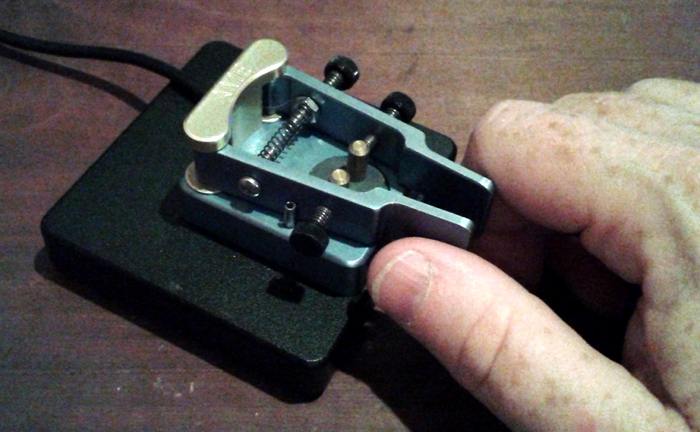
A popular way of sending Morse code is to use Iambic Paddles. The paddles are a set of two switches. They’re connected to an electronic device called a “keyer”, which generates dits and dahs in the proper rhythm. When you press on one of the paddles, a series of “dits” is produced, and the other paddle produces a string of “dahs”.
When you squeeze and hold both paddles simultaneously, the keyer produces an alternating series of dits and dahs. This is why it’s called “iambic” — the alternating dits and dahs sound a bit like iambic meter in poetry, with alternating stressed and unstressed syllables.
Most iambic keyers can be switched between two modes, called “mode A” and “mode B”. What’s the difference, and why should anyone care?
The difference involves what happens when you have been squeezing the paddles, and you then release both paddles simultaneously. If the keyer is in mode A, it will finish sending the current element (dit or dah), and then stop. If the keyer is in mode B, it will finish sending the current element, then send another element, and stop.
To illustrate, consider sending the letter “C”, which is “_._.” When sending in iambic mode A, you would release the paddles during the final dit, and the keyer would stop. When sending in iambic mode B, you would release the paddles during the final dah, and the keyer would finish that dah, send a final dit, and stop.
If you follow this strategy, your brain and fingers will get used to whichever mode you use, and you’ll naturally develop the timing to release paddles at the proper time to make the letters you want to make. And then, if you change to a keyer in a different mode, things won’t be right and you’ll make mistakes.
But there’s another way. Since the difference between the two modes only concerns what happens when you release both paddles simultaneously, it follows that if you never release both paddles simultaneously, you won’t notice the difference, and you’ll learn habits that will let you switch between modes with ease.
The secret is this: When you squeeze the paddles, release each paddle as it finishes its final element. That is, for a “C”, “_._.”, release the dah paddle during the final dah, and release the dit paddle during the final dit. For a period “._._._”, release the dit paddle during the final dit, and then release the dah paddle during the final dah. This will produce the correct sound regardless of whether the keyer is in iambic mode A or B.
Of course, another way of avoiding the difference between modes A and B is to avoid squeezing the paddles at all. This is OK, but you don’t get to enjoy the zen-like pleasure of sending code using the minimal possible relaxed motion of your fingers.
For a good tutorial on how to use an iambic keyer to send Morse code, see http://morse-rss-news.sourceforge.net/keyerdoc/K7QO_Iambic_Paddle.pdf
I learned to send iambic on an original Curtis mode A 8044 chip in the early 1980’s. All the modern “mode A” implementations that I have tried fail to correctly emulate C8044-A. If anyone who reads this is writing keyer code, please read and re-read this until you understand why nearly every implementation and published description of mode-A is not quite right:
The issue is what happens when you release a squeeze _after_ the final element is sent, but before the next element begins. With the Curtis-A chip, you could release _after_ the final dit of a C, and still be OK as long as the next dah hadn’t yet started. The modern implementations will all send an extra dah if you do that. When the final element is a dit, this moves the time window forward for releasing the squeeze by one dit length, assuming 50/50 weighting. This makes the botched mode A about halfway between true mode A and mode B.
The advantage of “real” mode A is that you can release the paddles _after_ you have heard the complete letter. All the modern implementations I have used require that you release the paddles before the letter is complete regardless of mode A/B. While people can and do learn to lead, and it works fine in the end, I will argue that it comes more naturally to end your keying effort after the letter is complete.
Before I got a rig that had the botched mode A on-board, I had trouble understanding why people didn’t like mode A….Now I understand that they probably have never tried “real” mode A. It took a while before I was able to put my finger on the reason that mode A on that rig only resulted in slightly fewer sending errors than I had when trying to use mode B.
Perhaps I will try to learn the sequenced release technique you describe in this article. It may be easier that trying to adjust to either “almost” mode A or mode B. Every new rig is smaller and lighter, and another generation or two, and my old C8044A keyer is going to be bigger and heavier than the rig.
73, ko0b
Very interesting! I have never used a genuine Curtis mode A chip, and was unaware of this difference between it and today’s common keyers. You’ve explained it clearly. Thanks for the comment.
73 de AG6QR